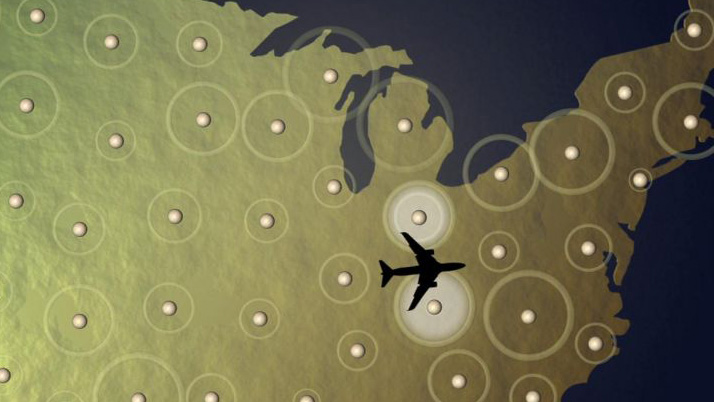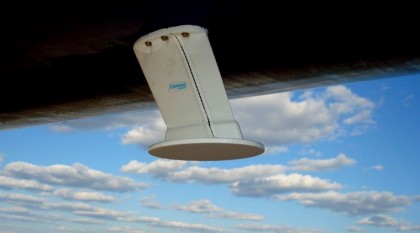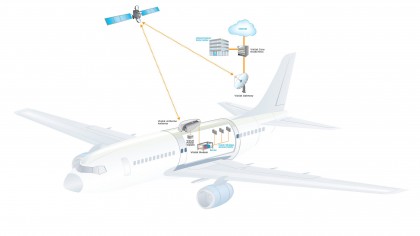How does airplane Wi-Fi work? And will it ever get any better?
Will in-flight internet ever be quick enough to stream?

Air travel has, for many years, been a largely phone-free zone. We've had to turn off our electronic devices, and rely instead on movies and in-flight magazines for entertainment.
Today, connectivity is much more important. Passengers don't just want to admire the view, or complain about a meal to their neighbor - they expect to be able to tweet about it, immediately, complete with pictures.
Many airlines are responding. In-flight Wi-Fi is now accessible on around 40% of US flights and on international long haul flights via companies such as Lufthansa, Emirates and Qatar Airways. Norwegian and Turkish airlines even offer the service for free, while Scandinavian airline SAS is testing it on some of its air craft now.
There are significant problems, though. Connections are often slow and unreliable. Prices can be high, perhaps £15/$20 or more - usually per device - for a full flight. And unsurprisingly users, for the most part, aren't happy.
"Only 28 per cent of business travellers are satisfied with in-flight Wi-Fi offered by airlines", said a 2012 FlightView survey of over 600 US passengers flying for work.
What's more, this situation is probably going to get worse before it gets better. Why? Let's get back to basics.
How plane Wi-Fi works
The key problem with airplane Wi-Fi is how you connect with the ground, and there are two main routes that companies might take.
Are you a pro? Subscribe to our newsletter
Sign up to the TechRadar Pro newsletter to get all the top news, opinion, features and guidance your business needs to succeed!
US provider GoGo has built a network of 3G ground stations all across the US, and planes communicate with these as they fly overhead. It's a simple system, but bandwidth can be limited to as little as 3.1Mbps (and that's for the entire flight, not per customer), so you can forget any ideas you had about streaming videos.
This is just the start, of course. The company is now rolling out its ATG-4 technology, equipping planes with dual modems and directional antennae, and this all helps boost total bandwidth to a theoretical maximum of 9.8Mbps - but that's still not very much. And it won't help at all when a plane flies out to sea and leaves the ground stations behind.

The alternative approach is for each plane to connect via satellite. Some use legacy L-band technology, now slow and relatively expensive. And that's why higher-frequency Ku-band (12-18GHz) satellites are the mainstream, relatively economical and delivering good performance. Lufthansa's FlyNet system, for instance, claims download speeds to the aircraft of up to 50Mbps, which isn't bad at all for the middle of the ocean.
From your point of view as a passenger, all you then have to do is connect to the system on the plane. Telecoms company OnAir takes a particularly convenient approach, the company told us: "OnAir offers the choice of GSM and Wi-Fi. 80% of passengers use Mobile OnAir, the GSM mobile phone network. You just turn on your phone, use it, and just like international roaming, the costs are included in your regular phone bill."
Connect via Wi-Fi instead and you'll have to pay according to your airline's own rules, which vary considerably: you might be able to pay by bandwidth, for time used (anything from a few minutes to a monthly unlimited pass), distance travelled and more. Choosing an individual option isn't difficult, but this does make it hard to compare the services on offer. If you're interested in airline Wi-Fi, be sure to read the small print extremely carefully.
Where next for in-flight Wi-Fi?
When you look at how much we're currently paying for frequently sub-standard plane connectivity, it's easy to assume the providers are just profiteering, cashing in on those who really need to be online all the time. But the reality isn't nearly as straightforward as that.
GoGo, for instance, has an 81% market share in the US, and increased its consolidated revenue by 46%, yet still managed to post a net loss of $32.7 million. It's never made a profit, and with competition increasing, some are wondering where the money is going to come from.
Other providers are in a similar position, and it leaves them with some real problems. It's hard to justify increasing the service price even more. But they can't cut it to get the volume of customers they need, either, because their onboard systems just don't have the bandwidth to cope.

In the short term, both providers and airlines are left searching for other ways to build a working business model. And the results so far are largely unconvincing.
California-based Row44 appears to think that it can make a lot of money by selling in-flight access to "quality entertainment", for instance. But why it thinks passengers will pay for their pre-packaged content, rather than just use the internet to access whatever they like, isn't entirely clear.
Aeroplane Wi-Fi has some significant issues at the moment, then, which is perhaps why some companies remain very cautious. British Airways, for instance, is reportedly planning a 12 month trial on just a single plane, since it clearly doesn't see a major commercial opportunity just yet.
Picking up speed
There is a major hope for the future, though, in Ka-band (26.5-40GHz) satellites, which promise perhaps 100 times the capacity of regular Ku-band. Satellite company ViaSat explained: "Our high-capacity satellite system delivers more bandwidth than other air-to-ground or satellite IFC systems, eclipsing the quality and speeds of other in-cabin airline broadband services while offering the best value to the airlines."
What level of bandwidth is that? "Our Exede In The Air system can provide a service level agreement that delivers 12Mbps speeds to each passenger." Now that's the kind of performance people might be willing to pay for.
The service doesn't have to come at a premium price, either: Ka-band has so much bandwidth that the cost should fall, as mobile satellite technology consultant Tim Farrar of TMF Associates points out: "ViaSat's Ka-band satellite could reduce the capacity cost by a factor of up to about five times".

We shouldn't take this entirely for granted, of course - Ka-band is a relatively new technology with issues still to be resolved (including latency), and exactly how it will cope when perhaps half a plane full of passengers want to watch movies at Netflix isn't yet clear.
It does seem the closest yet to delivering genuine broadband performance on a plane, though, and with US airline JetBlue launching its ViaSat-based service later this year, plus GoGo and others joining the Ka-band party in 2014, we should all be seeing far more usable, reliable and affordable in-flight Wi-Fi very soon.

Mike is a lead security reviewer at Future, where he stress-tests VPNs, antivirus and more to find out which services are sure to keep you safe, and which are best avoided. Mike began his career as a lead software developer in the engineering world, where his creations were used by big-name companies from Rolls Royce to British Nuclear Fuels and British Aerospace. The early PC viruses caught Mike's attention, and he developed an interest in analyzing malware, and learning the low-level technical details of how Windows and network security work under the hood.